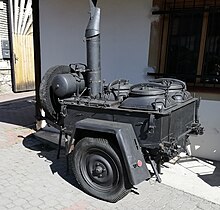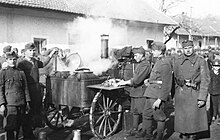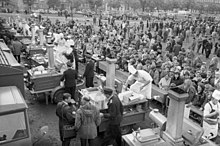Field kitchen
This articleneeds additional citations forverification.(February 2013) |

Afield kitchen(also known as abattlefield kitchen,expeditionary kitchen,flying kitchen,orgoulash cannon) is akitchenused primarily bymilitariesto provide hot food to troops near thefront lineor in temporary encampments. Designed to be easily and quickly moved, they are usuallymobile kitchensormobile canteens,though static andtent-based field kitchens exist and are widely used.
History
[edit]
The first field kitchens were carried in four-wheeledwagons(such aschuckwagons) by military units on campaigns throughout history, often part of largerwagon trains,used as late as the 19th century. By the 20th century, smaller two-wheeledtrailersbecame common, especially with the invention of thelocomotive.
Karl Rudolf Fissler ofIdar-Obersteininvented a mobile field kitchen in 1892 that the Germans came to refer to as aGulaschkanone( "goulash cannon" ), because the chimney of the stove resembledordnance pieces[1]when disassembled and limbered for towing. As technology advanced, larger trailers evolved as horses were phased out in favor of motorized vehicles more capable of towing heavier loads. InWorld War II,the mobile canteen was used as a morale booster in the United Kingdom, fitting in with the culture of thetea breakand in particular as a result of the successful wartime experiment of thetea ladyon productivity and morale.[2]The larger mobile kitchens (now commonly called "flying kitchens" because of the greater speed with which they can be deployed) can service entire battalions of troops.
In the present, many field kitchens are mostly either mobile canteens or deployable field kitchens. Many of these have facilities similar to actual kitchen facilities, and may be designed to serve either fresh meals or hot food rations intended to be prepared in a field kitchen.
Types
[edit]
Trailer kitchen
[edit]A trailer kitchen, rolling kitchen, or chow wagon is a field kitchen that is or can be pulled by a vehicle,pack animal,or person in the form of a cart, wagon, or trailer. They typically have two or four wheels and may be a single unit or two separate units connected to each other. Such trailers may have wheels with the intent that they are pulled to their destinations, or they may be assembled at their destination with the wheels only intended to make it easier to move around if needed. Most trailer kitchens are open-air, though some vehicle-towed trailer kitchens may be enclosed.
Assault kitchen
[edit]An assault kitchen or vehicle kitchen is a field kitchen that is installed in a vehicle. It is usually in the rear compartment of the vehicle, which may be amilitary light utility vehicle,avan,or atruck.They may function similar to a commercialfood truck,or they may simply be a kitchen in the back of a vehicle without dedicated serving functions. Assault kitchens allow for meals to be prepared while moving and without the need to wait for a field kitchen to be set up, allowing for the quick preparation and serving of hot meals to troops and, if necessary, a quick extraction of the kitchen and food supplies from a dangerous area.[3][4]
Deployable kitchen
[edit]A deployable kitchen or camp kitchen is a field kitchen that is deployed as a static structure. Though they are not necessarily mobile kitchens, they are designed to be unpacked, assembled, and repacked with relative haste. They may be as small as a set ofoutdoor cookingequipment that can take only a few minutes to set up; as basic asfolding tableswith a portablekitchen range,ration heating unit, and food containers; or as large as a tent-based kitchen with a full set of appliances that may take up to an hour to fully set up for food preparation.[3]
Containerized kitchen
[edit]A containerized kitchen, modular kitchen, or configurable kitchen is a field kitchen that is enclosed within, or in a similar configuration to, afreight container,typically ashipping containerorsemi-trailer.They are very similar to deployable kitchens, but larger, usually not assembled by hand, and intended to feed more individuals or prepare more types of food than what is possible with other types of field kitchens. They are typicallymodular buildingsthat can be expanded if necessary.[5][6]
Other facilities
[edit]Some modern militaries use mobile facilities that are not field kitchens, but supplement them or are components of them, such as large tents for dining halls. The U.S.Defense Logistics Agencylists several such facilities used by theUnited States Armed Forces,including the Multi-Temperature Refrigerated Container System, a containerizedfreezer;the Food Sanitation Center, a dedicateddishwashingtent; and the Containerized Ice Making System, a containerizedicemakerdesigned to mass-produce ice.[3][6]
Non-military use
[edit]
Field kitchens are also used in non-military or non-combat roles. Field kitchens are deployed by militaries oraid agenciesto feed groups of refugees, displaced persons, or first responders as part ofhumanitarian aid,disaster response,andemergency managementoperations.[7]Field kitchens are also sometimes set up forhistorical reenactments,preferably with genuine field kitchen appliances or newer reproductions, though modern equivalents are sometimes used, especially if the field kitchen appliances fail.[8]
Civilian versions of field kitchens have also been set up at events where dedicated food service facilities are unavailable, such as atprotests;for example, several were set up inMaidan NezalezhnostiduringEuromaidan,[9]and one was set up inConfederation Squareduring theCanada convoy protests.[10]
Gallery
[edit]-
A field bakery used by theGrande Armée,captured at theBattle of Waterlooand displayed at theRoyal Logistic Corps Museum
-
Imperial German Armytrailer kitchen at theAustralian War Memorial
-
Japan Ground Self-Defense Forcesoldiers preparing meals on ayagai suigutrailer kitchen
-
Georgia Air National Guardcooks preparingUnitized Group Rationsin a trailer kitchen
-
An early vehicle kitchen in the back of a truck, built for theAmerican Expeditionary ForcesduringWorld War I
-
U.S. Army Reservesoldiers unpacking aHumvee-based assault kitchen
-
Bread dough being prepared in aRussian Armed ForcesPAK-200M vehicle kitchen
-
ASwiss Armed Forcesdeployable kitchen, designed to feed onesquad
-
A single palletized expeditionary kitchen, an American containerized kitchen, used here by theU.S. Air Force
See also
[edit]References
[edit]- ^"What is a Goulash Cannon?".Carriage Association of America.Retrieved21 May2024.
- ^"Your Mobile Canteen in Action".VADS.Imperial War Museum. Archived fromthe originalon 5 October 2011.Retrieved25 July2010.
- ^abc"Army Field Feeding Systems"(PDF).3 August 2017.Archived(PDF)from the original on 26 February 2023.Retrieved25 February2023.
- ^"The Army Assault Kitchen".Babington Technology.Archivedfrom the original on 26 February 2023.Retrieved25 February2023.
- ^"Containerized Kitchen NSN 7360-01-473-3408"(PDF).U.S. Army Quartermaster Corps. 28 June 2010.Archived(PDF)from the original on 26 February 2023.Retrieved25 February2023.
- ^ab"Kitchens".Defense Standardization Program.Defense Logistics Agency.Archivedfrom the original on 26 February 2023.Retrieved25 February2023.
- ^"Babington Disaster Relief Mobile Kitchen Trailer".Babington Technology.Archivedfrom the original on 26 February 2023.Retrieved25 February2023.
- ^Ly, Phuong (8 August 2005)."Vietnam Buffs Bring Jungle to Va".The Washington Post.Retrieved25 February2023.
- ^Ilkiv, Taras (23 January 2014)."A Ukrainian Journalist Explains 10 Things The West Needs To Know About The Situation In Kiev".Business Insider.Archivedfrom the original on 26 February 2023.Retrieved25 February2023.
- ^Pringle, Josh; Rooy, Natalie van (6 February 2022)."Protesters move supplies, wooden shed out of downtown Ottawa park".CTV News Ottawa.Archivedfrom the original on 26 February 2023.Retrieved25 February2023.
External links
[edit] Media related toField kitchensat Wikimedia Commons
Media related toField kitchensat Wikimedia Commons











